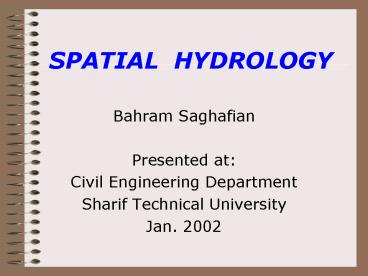SPATIAL HYDROLOGY - PowerPoint PPT Presentation
1 / 33
Title:
SPATIAL HYDROLOGY
Description:
Study of the motion of the earth's waters (and the transport of their ... Introduce, for the first time, temporally-variable isochrone hydrograph estimation method ... – PowerPoint PPT presentation
Number of Views:188
Avg rating:3.0/5.0
Title: SPATIAL HYDROLOGY
1
SPATIAL HYDROLOGY
- Bahram Saghafian
- Presented at
- Civil Engineering Department
- Sharif Technical University
- Jan. 2002
2
What is Spatial Hydrology?
- Study of the motion of the earths waters (and
the transport of their constituents) with the
explicit reference to the spatial dimension and
using the data structure and functions of
geographic information systems
3
Major Developments
- Increasing availability of spatial hydrologic
data (DEM, Images, etc.) - Inclination towards the use of spatial data bases
and GIS functions in hydrology - Need to study detailed spatial distribution of
hydrologic processes and their effects - Development of distributed hydrologic models
- Need to disaggregate synthesized hydrologic
responses (flood hydrograph, sediment load, etc.) - Progress in high-powered computing equipments
4
Active Areas in Spatial Surface Hydrology
- Effect of land use changes
- Floodplain mapping and hazard
- Flood potential and risk mapping within
watersheds - Spatial optimization of flood control
countermeasures - Site selection for hydro-climatological stations
- Distributed watershed erosion mapping
- Pollutant affected areas
- Distributed runoff/snowmelt/sediment modeling
- Spatial correlation of climatological factors
with geo-environmental characteristics - Distributed modeling of hydro-climatologic and
geo-morphologic characteristics
5
Geographic Information System
- Software tool for storing, managing, manipulating
spatial (geographic) data - Has four components data entry, data management,
manipulation and analysis, and data output - Models geographic features using points, lines,
and cells in either vector or cellular data
models
6
(No Transcript)
7
GIS Relation to Spatial Hydrology
- Spatial hydrology deals with spatially
distributed processes and features - GIS can handle spatial (geographic) data
- Conjunctive use of GIS and hydrology is natural
and unavoidable
8
Distributed Rainfall-Runoff Modeling of
Golabdareh Catchment
9
Distinctive Algorithms and Tools
- Upgrade time-area rainfall-runoff transformation
into a distributed technique - Determine travel time based on kinematic wave
theory - Introduce, for the first time, temporally-variable
isochrone hydrograph estimation method
10
(No Transcript)
11
(No Transcript)
12
Digitally extracted drainage network
13
(No Transcript)
14
(No Transcript)
15
50-yr Flood Hydrograph
16
Effect of Land Use Changes in Nekarood River
Basin
- Land use change detection using remotely-sensed
data - Hydrologic simulation of floods
- Prediction of future effects based of land use
change scenarios - Further application How to manage spatially the
timber harvesting and other land activities
17
View of Nekarood River Basin
18
View of Nekarood River Basin
19
Digital Elevation Model (DEM)
20
Land Use Map, Year 1346
21
Land Use map, Year 1372
22
Land Use Map, Year 1379
23
Land Use Change Over Years
24
Change in peak floods
25
Sediment Deposition Spatial PatternMinab Dam
26
Spatial correlation between rainfall and
vegetation
- Daily rainfall maps using geostatistical tools
- Terrain mapping units defined
- NOAA satellite images processed for NDVI
vegetation index - Spatial correlation of rainfall and NDVI studied
on 10-day and monthly basis with different lag
times
27
Terrain mapping Units
28
Sample daily rainfall map
29
Results
- Monthly NDVI vegetation index follow monthly
rainfall data with a lag of one to two months and
are best correlated with the bimonthly antecedent
rainfall. - The multiple regression method is best suited
compared with others methods. - Results may be used for rainfall spatial
variation and drought mapping.
30
Drought SDF Mapping
- Drought Severity-Duration-Frequency analysis
using run theory - Spatial extent of drought severity
31
Flood Potential Prioritization and Spatial
Mapping
- Set up a selected semi-distributed hydrologic
model for the watershed - Identify and rank the areas (sub-watersheds)
based on their quantitative contribution in
discharge characteristics at the outlet - Determine the impact of sub-watershed factors on
the outlet flood peak - Propose priority flood control measures
- Ongoing conduct research on observed discharge
data and/or use a fully distributed model
32
Snow Mapping Snowmelt Runoff Simulation
- Use satellite images for continuous mapping
- Propose an algorithm for snow/cloud/ground
delineation - Simulate snowmelt and rainfall runoff using SRM
model and processed images
33
The End































